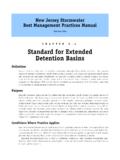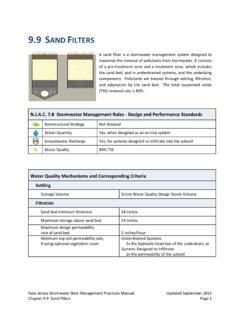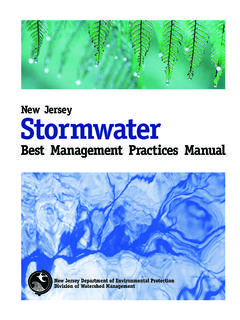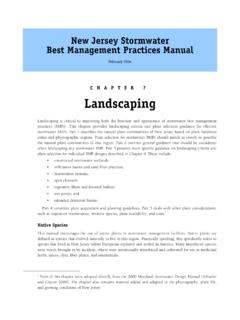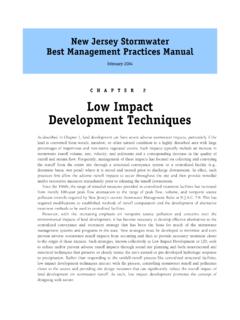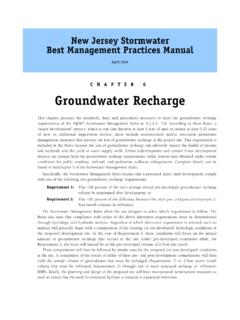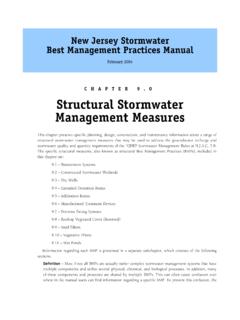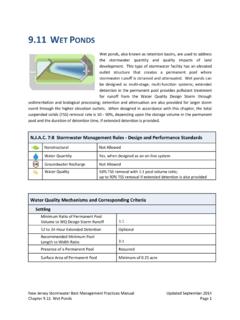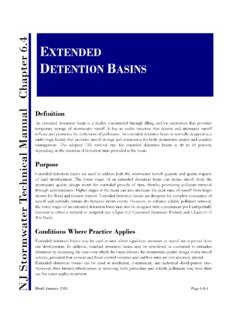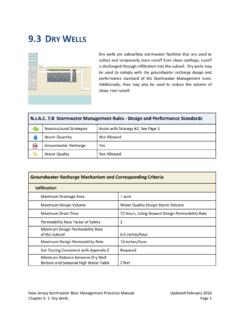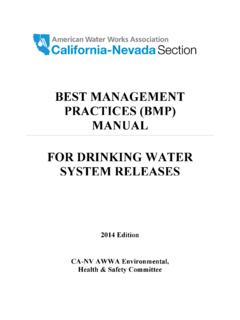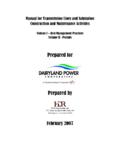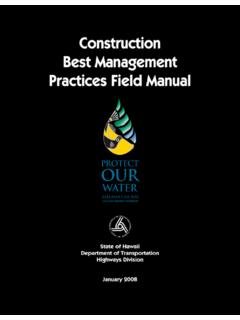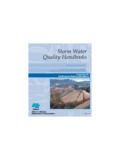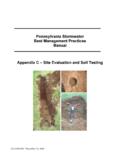Transcription of 9.13 SUBSURFACE GRAVEL WETLANDS - njstormwater.org
1 New Jersey Stormwater Best Management Practice manual Updated September 2014 Chapter SUBSURFACE GRAVEL WETLANDS Page 1 SUBSURFACE GRAVEL WETLANDS A SUBSURFACE GRAVEL wetland is a stormwater management system designed to maximize the removal of pollutants from stormwater; the system is a combination of a surface marsh and a SUBSURFACE GRAVEL bed. Pollutants are treated through settling, both uptake and filtration by vegetation, and chemical transformation in the SUBSURFACE bed, specifically denitrification. Both the total suspended solids (TSS) removal rate and the nitrogen removal rate are 90%.
2 7:8 Stormwater Management Rules - Design and Performance Standards Nonstructural Strategy Assist with Strategy #7; See Page 2 Water Quantity Not Allowed Groundwater Recharge Not Allowed Water Quality 90% TSS; 90% Nitrogen Water Quality Mechanisms and Corresponding Criteria Settling Pretreatment Required Presence of Surface WETLANDS Required Vegetative Uptake and Filtration Minimum Density of Vegetation 85% Appropriate Species Selection See Chapter 7: Landscaping Denitrification Submerged GRAVEL Cells Required New Jersey Stormwater Best Management Practice manual Updated September 2014 Chapter SUBSURFACE GRAVEL WETLANDS Page 2 Introduction SUBSURFACE GRAVEL WETLANDS are stormwater management systems used to address the stormwater runoff quality impacts of land development.
3 This type of stormwater facility is a combination of a surface marsh and a SUBSURFACE GRAVEL bed. In the surface marsh, pollutants in runoff are treated through filtration and biological uptake by the marsh vegetation and through settling. Runoff flows vertically from the surface marsh through a perforated pipe into the saturated GRAVEL bed, located directly below the surface marsh. Runoff then moves horizontally through the GRAVEL where pollutants are treated by chemical transformation, specifically denitrification.
4 Denitrification is a microbially-facilitated, multi-step process whereby nitrogen compounds in runoff are transformed to nitrogen gas. The nitrogen gas is then permanently removed from the system via the soil into the atmosphere. In addition to pollutant removal, these systems can also provide wildlife habitat and enhance the aesthetics of a site. However, these systems are designed primarily for the treatment of stormwater runoff, so they should not be sited within natural wetland areas because they will not have the full range of ecological functions.
5 SUBSURFACE GRAVEL WETLANDS must have a maintenance plan and should be protected by easement, deed restriction, ordinance or other legal measures that prevent its neglect, adverse alteration or removal. Applications The nonstructural stormwater management strategies design standard in the Stormwater Management rules must be addressed for all major development, pursuant to 7 (a). The site evaluation for nonstructural strategies should consider all nine strategies. The design of a submerged GRAVEL wetland can assist in maximizing the following strategy: Strategy #7: The provision of low maintenance landscaping, which encourages retention, the planting of native vegetation, and minimizes the use of lawns, fertilizers and pesticides.
6 To receive credit for a TSS removal rate of 90%, SUBSURFACE GRAVEL WETLANDS must be designed to treat the stormwater runoff volume generated by the Water Quality Design Storm and in accordance with all of the criteria below. New Jersey Stormwater Best Management Practice manual Updated September 2014 Chapter SUBSURFACE GRAVEL WETLANDS Page 3 Design Criteria Basic Requirements The following design criteria must be met in order to receive the 90% TSS and nitrogen removal rates for this BMP. It is critical that all SUBSURFACE GRAVEL WETLANDS are designed in accordance with these criteria in order to ensure proper operation, to maximize the functional life of the system, and to ensure public safety.
7 Pretreatment Pretreatment is required in all SUBSURFACE GRAVEL WETLANDS . Pretreatment reduces the velocity of incoming flows and captures coarser sediments and debris. Pretreatment may consist of a forebay or any of the structural BMPs found in Chapter 9: Structural Stormwater Management Measures. There is no adopted TSS removal rate associated with forebays; therefore, their inclusion in any design should be solely for the purpose of facilitating maintenance. Forebays can be earthen, constructed of riprap, or made of concrete, and must comply with the following requirements: The forebay must be designed to prevent scour of the receiving basin by outflow from the forebay.
8 The forebay should provide a minimum storage volume of 10% of the Water Quality Design Storm and be sized to hold the sediment volume expected between clean-outs. It should fully drain within nine hours in order to facilitate maintenance and to prevent mosquito issues. Under no circumstances should there be any standing water in the forebay 72 hours after a precipitation event. Surface forebays must meet or exceed the sizing for preformed scour holes in the Standard for Conduit Outlet Protection in the Standards for Soil Erosion and Sediment Control in New Jersey for a surface forebay.
9 If a concrete forebay is utilized, it must have at least two weep holes to facilitate low level drainage. When using a structural BMP for pretreatment, it must be designed in accordance with the design requirements outlined in the respective chapter. For additional information on the design requirements of each structural BMP, refer to the appropriate chapter in this manual . Inflow Erosion Control The discharge from the inflow pipes must be designed to prevent erosion in any portion of the GRAVEL wetland system, particularly where stormwater runoff generated by storms larger than the Water Quality Design Storm bypass the system.
10 The bypass must be designed to prevent erosion at the weir structures that could occur due to frequent inundation and high flow velocities. New Jersey Stormwater Best Management Practice manual Updated September 2014 Chapter SUBSURFACE GRAVEL WETLANDS Page 4 Vegetation The character, diversity and hardiness of the wetland vegetation must be sufficient to provide adequate pollutant removal. The minimum density of vegetation in the surface wetland cells is 85%. Hydraulics Each surface wetland cell in a SUBSURFACE GRAVEL wetland system must be sized to contain 50% of stormwater runoff generated by the Water Quality Design Storm without overflow.

